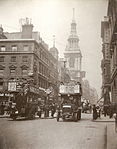Blossom's Inn
Coaching innsDemolished buildings and structures in LondonFormer pubs in LondonGreat Eastern RailwayHistory of the City of London ... and 2 more
Pages containing links to subscription-only contentPubs in the City of London

Blossom's Inn was a tavern which stood in Lawrence Lane in the City of London from the 14th century until 1855. It became a substantial coaching inn and was used as a staging post by carriers of goods. In the 19th century, the lease was bought and it became the parcel depot of the Great Eastern Railway. Its name was used for a major property development at the end of the 20th century and the site is now part of the large complex of 30 Gresham Street.
Excerpt from the Wikipedia article Blossom's Inn (License: CC BY-SA 3.0, Authors, Images).Blossom's Inn
Trump Street, City of London
Geographical coordinates (GPS) Address Nearby Places Show on map
Geographical coordinates (GPS)
| Latitude | Longitude |
|---|---|
| N 51.5145 ° | E -0.0928 ° |
Address
Sweatshop
Trump Street 6
EC2V 8AF City of London
England, United Kingdom
Open on Google Maps











